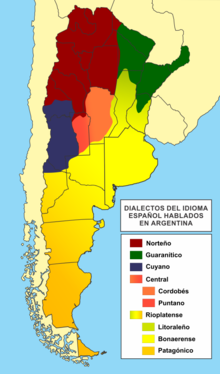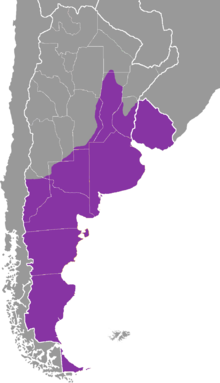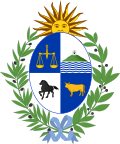| Rioplatense Spanish | |
|---|---|
| Argentine–Uruguayan Spanish | |
| Castellano rioplatense[1] (Castellano argentino-uruguayo) | |
| Pronunciation | [kasteˈʝano ri.oplaˈtense] |
| Native to | Argentina, Uruguay |
| Ethnicity | Argentines Uruguayans |
Early forms | |
| Dialects | Outer Dialects: Norteño (Northern) Guaranítico (Northeastern) Cuyano (Western) Cordobés (Central) Inner Dialects: Litoraleño (Coastal) Bonaerense (Eastern) Patagónico (Southern) Uruguayan |
| Latin (Spanish alphabet) | |
| Official status | |
Official language in | |
| Regulated by | Academia Argentina de Letras Academia Nacional de Letras de Uruguay |
| Language codes | |
| ISO 639-1 | es |
| ISO 639-2 | spa[3] |
| ISO 639-3 | – |
| Glottolog | None |
| IETF | es-AR |
 Spanish dialects in Argentina | |

Rioplatense Spanish (/ˌriːoʊpləˈtɛnseɪ/ REE-oh-plə-TEN-say, Spanish: [ri.oplaˈtense]), also known as Rioplatense Castilian,[4] or River Plate Spanish,[5] is a variety of Spanish[6][7][8] originating in and around the Río de la Plata Basin, and now spoken throughout most of Argentina and Uruguay.[9] It is the most prominent dialect to employ voseo (the use of vos in place of the pronoun tú, along with special accompanying conjugations) in both speech and writing. Many features of Rioplatense are also shared with the varieties spoken in south and eastern Bolivia, and Paraguay. This dialect is influenced by Italian languages, due to the historically significant Italian immigration in the area, and therefore has several Italian loanwords and is often spoken with an intonation resembling that of the Neapolitan language of Southern Italy.
| Part of a series on the |
| Culture of Argentina |
|---|
 |
| Society |
| Topics |
| Symbols |
|
|
| This article is part of a series on the |
| Culture of Uruguay |
|---|
 |
|
Uruguay Portal |
As Rioplatense is considered a dialect of Spanish and not a distinct language, there are no credible figures for a total number of speakers. The total population of these areas would amount to some 25–30 million, depending on the definition and expanse.
- ^ "Sudamérica prefiere el término «castellano» y Centroamérica el de «español»" (in Spanish). 6 August 2007. Retrieved 2023-07-08.
- ^ Spanish → Argentina & Uruguay at Ethnologue (21st ed., 2018)

- ^ "ISO 639-2 Language Code search". Library of Congress. Retrieved 21 September 2017.
- ^ Del Valle, José, ed. (2013). A Political History of Spanish: The Making of a Language. Cambridge University Press. pp. 212–228. ISBN 9781107005730.
- ^ Saab, Andrés. (2009). "On verbal duplication in River Plate Spanish". Selected papers from Going Romance. Nice 2009.
- ^ Orlando Alba, Zonificación dialectal del español en América ("Classification of the Spanish Language within Dialectal Zones in America"), in: César Hernández Alonso (ed.), "Historia presente del español de América", Pabecal: Junta de Castilla y León, 1992.
- ^ "Jiří Černý, "Algunas observaciones sobre el español hablado en América" ("Some Observations about the Spanish Spoken in America"). Acta Universitatis Palackianae Olomucencis, Facultas Philosophica Philologica 74, pp. 39-48, 2002" (PDF). Archived from the original (PDF) on 2014-08-01. Retrieved 2009-01-29.
- ^ Alvar, Manuel, "Manual de dialectología hispánica. El español de América", ("Handbook of Hispanic Dialectology. Spanish Language in America."). Barcelona 1996.
- ^ Resnick, Melvyn: Phonological Variants and Dialects Identification in Latin American Spanish. The Hague 1975.